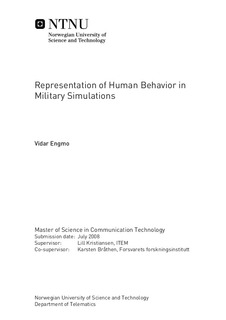| dc.contributor.advisor | Kristiansen, Lill | nb_NO |
| dc.contributor.advisor | Bråthen, Karsten | nb_NO |
| dc.contributor.author | Engmo, Vidar | nb_NO |
| dc.date.accessioned | 2014-12-19T14:12:55Z | |
| dc.date.available | 2014-12-19T14:12:55Z | |
| dc.date.created | 2010-09-04 | nb_NO |
| dc.date.issued | 2008 | nb_NO |
| dc.identifier | 348717 | nb_NO |
| dc.identifier | ntnudaim:4222 | nb_NO |
| dc.identifier.uri | http://hdl.handle.net/11250/261973 | |
| dc.description.abstract | The purpose of this master thesis was to investigate the psychological and computational basis for human behavior representation (HBR) in military simulations and identify problem areas of existent software agent frameworks that provide computer generated forces (CGF) with human like cognitive abilities. The master thesis identifies psychological properties that influence human cognition in an operational environment through a theoretical study of operational and cognitive psychology. The psychological properties of human cognition are then connected to artificial intelligence through a theoretical study of agents and multi-agent systems and form the foundation for identifying general HBR properties. The HBR properties are used as evaluation markers that constitute the basis for constructing an evaluation of relevant agent frameworks thereby visualizing their strengths and weaknesses. The problem areas of incorporating artificial intelligence into CGF are further concretized by the development of a demonstrator that interacts with a synthetic environment. The demonstrator is an implementation of a tank platoon in the agent framework Jadex. The synthetic environment is provided by VR-Forces which is a product by MÄK technologies. The thesis makes a distinction between the conceptual structure of agent frameworks and their actual implementation. According to this master thesis it is the output of the agent framework that is the most important feature not how the output came into being. Producing the correct output requires the selection of the correct tools for the job. The selection of an agent framework should be taken on the background of an evaluation of the simulation requirements. A large portion of the development time is consumed by the development of application and communication interfaces. The problem is a result of lacking standardization and that most cognitive agent frameworks are experimental in nature. In addition the artificial intelligence (AI) in such simulations is often dived into levels, where the synthetic environment takes care of low-level AI and the agent framework the high-level AI. Tight synchronization between low and high-level AI is important if one wishes to create sensible behavior. The purpose of an agent framework in conjunction with CGF is thereby ensuring rapid development and testing of behavior models. | nb_NO |
| dc.language | eng | nb_NO |
| dc.publisher | Institutt for telematikk | nb_NO |
| dc.subject | ntnudaim | no_NO |
| dc.subject | SIE7 kommunikasjonsteknologi | no_NO |
| dc.subject | Telematikk | no_NO |
| dc.title | Representation of Human Behavior in Military Simulations | nb_NO |
| dc.type | Master thesis | nb_NO |
| dc.source.pagenumber | 201 | nb_NO |
| dc.contributor.department | Norges teknisk-naturvitenskapelige universitet, Fakultet for informasjonsteknologi, matematikk og elektroteknikk, Institutt for telematikk | nb_NO |

